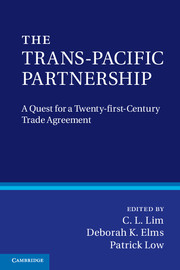Book contents
- Frontmatter
- Contents
- List of Figures and Tables
- Contributors
- Preface
- Acknowledgements
- Disclaimer
- Glossary
- Part I Introduction
- Part II The past: origins of the TPP Agreement
- Part III The present: twenty-first century elements and obstacles
- 6 Negotiations over market access in goods
- 7 TPP negotiations
- 8 Trade in services
- 9 TPP Agreement
- 10 The intellectual property chapter in the TPP
- 11 Regulatory coherence in the TPP talks
- 12 Environmental issues in the TPP
- 13 Labour standards and the TPP
- 14 What is to be done with export restrictions?
- Part IV The future: high-quality meets regional and global realities
- Part V The TPP negotiations: the quest for quality
- Index
- References
9 - TPP Agreement
towards innovations in investment rule-making
Published online by Cambridge University Press: 05 November 2012
- Frontmatter
- Contents
- List of Figures and Tables
- Contributors
- Preface
- Acknowledgements
- Disclaimer
- Glossary
- Part I Introduction
- Part II The past: origins of the TPP Agreement
- Part III The present: twenty-first century elements and obstacles
- 6 Negotiations over market access in goods
- 7 TPP negotiations
- 8 Trade in services
- 9 TPP Agreement
- 10 The intellectual property chapter in the TPP
- 11 Regulatory coherence in the TPP talks
- 12 Environmental issues in the TPP
- 13 Labour standards and the TPP
- 14 What is to be done with export restrictions?
- Part IV The future: high-quality meets regional and global realities
- Part V The TPP negotiations: the quest for quality
- Index
- References
Summary
Introduction
The Trans-Pacific Partnership (TPP) negotiations seek to address the international regulation of foreign investment, a key issue for all participating countries. Although national laws and policies still constitute the most concrete and detailed part of the legal framework of foreign direct investment (FDI), the current system has become increasingly dependent on international investment agreements (IIAs). IIAs are treaties between states which serve as instruments of cooperation for the promotion, protection and liberalization of foreign investment. IIAs exist in three main forms: bilateral investment treaties (BITs) signed by two states; regional investment treaties signed by groups of states within a single region; and chapters of integrated trade and investment agreements that can be signed at the bilateral or regional level. With the numbers of BITs and regional trade agreements (RTAs) increasing, different standards and disciplines are beginning to be exerted over foreign investments. The legal framework of IIAs has also evolved significantly, as the growing jurisprudence raises new questions of interpretation and implementation for both governments and investors in both developed and developing countries. Consequently, the number of international investment disputes arising from investment agreements has increased sharply.
The initial P4 Agreement of 2006 requires parties to commence negotiations on an investment chapter, meaning that negotiations had to start from scratch with the expanded group of TPP countries. It was only in the Second Round of Negotiations that the investment working group was established in San Francisco, on June 17, 2010. Since then, the negotiations have featured many exchanges, with NGOs invited to be onsite during the rounds. The first exchange of initial offers took place at the Sixth Round in Singapore in April 2011. Though the 2006 P4 Agreement did not contain any rules on investment, the parties to negotiations have signed several IIAs with each other or with third countries, and they view the TPP as a way of expanding and improving on these for the region.
- Type
- Chapter
- Information
- The Trans-Pacific PartnershipA Quest for a Twenty-first Century Trade Agreement, pp. 147 - 156Publisher: Cambridge University PressPrint publication year: 2012
References
- 6
- Cited by

